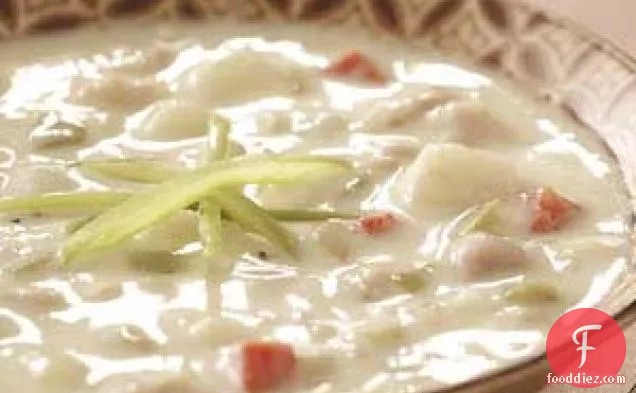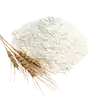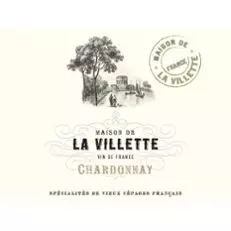Makeover Mom's Clam Chowder

Makeover Mom's Clam Chowder is an American hor d'oeuvre. This recipe covers 7% of your daily requirements of vitamins and minerals. One portion of this dish contains around 5g of protein, 7g of fat, and This recipe from Taste of Home requires onion, curry powder, clams, and clam juice. If you like this recipe, you might also like recipes such as Mom's Clam Chowder, Mom's New England Clam Chowder, and Mom's Clam Chowder Soup.
Instructions
1
In a Dutch oven over medium heat, cook the onion, celery, carrots and green pepper in butter until tender. Stir in the broth, clam juice, bouillon and seasonings.
Ingredients you will need![Green Pepper]() Green Pepper
Green Pepper![Clam Juice]() Clam Juice
Clam Juice![Seasoning]() Seasoning
Seasoning![Bouillon]() Bouillon
Bouillon![Carrot]() Carrot
Carrot![Butter]() Butter
Butter![Celery]() Celery
Celery![Broth]() Broth
Broth![Onion]() Onion
Onion
Equipment you will use![Dutch Oven]() Dutch Oven
Dutch Oven
2
Add potato. Bring to a boil. Reduce heat; simmer, uncovered, for 15-20 minutes or until potato is tender.
Ingredients you will need![Potato]() Potato
Potato
Ingredients
1![bay leaf]() bay leaf59milliliters
bay leaf59milliliters![butter, cubed]() butter, cubed2teaspoons
butter, cubed2teaspoons![reduced-sodium chicken bouillon granules]() reduced-sodium chicken bouillon granules907grams
reduced-sodium chicken bouillon granules907grams![carton reduced-sodium chicken broth]() carton reduced-sodium chicken broth227grams
carton reduced-sodium chicken broth227grams![bottle clam juice]() bottle clam juice737grams
bottle clam juice737grams![cans each) minced clams, undrained]() cans each) minced clams, undrained0teaspoons
cans each) minced clams, undrained0teaspoons![curry powder]() curry powder1teaspoons
curry powder1teaspoons![dried parsley flakes]() dried parsley flakes158milliliters
dried parsley flakes158milliliters![all-purpose flour]() all-purpose flour118milliliters
all-purpose flour118milliliters![chopped green pepper]() chopped green pepper237milliliters
chopped green pepper237milliliters![half-and-half cream]() half-and-half cream473milliliters
half-and-half cream473milliliters![2% milk, divided]() 2% milk, divided177milliliters
2% milk, divided177milliliters![each chopped onion, celery and carrots]() each chopped onion, celery and carrots0teaspoons
each chopped onion, celery and carrots0teaspoons![pepper]() pepper1medium
pepper1medium![potato, peeled and cubed]() potato, peeled and cubed1teaspoons
potato, peeled and cubed1teaspoons![salt]() salt
salt
 bay leaf59milliliters
bay leaf59milliliters butter, cubed2teaspoons
butter, cubed2teaspoons reduced-sodium chicken bouillon granules907grams
reduced-sodium chicken bouillon granules907grams carton reduced-sodium chicken broth227grams
carton reduced-sodium chicken broth227grams bottle clam juice737grams
bottle clam juice737grams cans each) minced clams, undrained0teaspoons
cans each) minced clams, undrained0teaspoons curry powder1teaspoons
curry powder1teaspoons dried parsley flakes158milliliters
dried parsley flakes158milliliters all-purpose flour118milliliters
all-purpose flour118milliliters chopped green pepper237milliliters
chopped green pepper237milliliters half-and-half cream473milliliters
half-and-half cream473milliliters 2% milk, divided177milliliters
2% milk, divided177milliliters each chopped onion, celery and carrots0teaspoons
each chopped onion, celery and carrots0teaspoons pepper1medium
pepper1medium potato, peeled and cubed1teaspoons
potato, peeled and cubed1teaspoons salt
saltRecommended wine: Chardonnay, Alcoholic Drink, White Wine, Ingredient, Food Product Category, Sauvignon Blanc, Wine, Dry White Wine, Riesling, Drink, Menu Item Type
Chardonnay, Alcoholic Drink, and White Wine are my top picks for Clam Chowder. Chowder can benefit from a crisp white to cut through the rich, creamy broth - or you can go big or go home with a rich, buttery chardonnay. You could try Maison de la Villette Chardonnay. Reviewers quite like it with a 5 out of 5 star rating and a price of about 14 dollars per bottle.

Maison de la Villette Chardonnay
Lovely golden color with a subtle nose of white flowers and citrus. A refreshing and complex white wine with lemon pie, fresh banana and pear scents followed by roasted hints of praline, vanilla and candied chestnuts. Perfect served on its own as an aperitif or with seafood, grilled fishes and salads.10 to 12 day fermentation with both French and American oak is followed by a soft 6 month maturation on the wine’s natural lies. About half of the final blend completes malolactic fermentation, which allows to keep some natural acidity. An early bottling allows to capture freshness and primary flavors.DifficultyExpert
Ready In1 h, 15 m.
Servings12
Health Score2
Magazine

Your Inner Chef with Taylor Swift's Top 3 Recipes from Her Beloved NYC Hangout

20 Mouthwatering Recipes You Need to Try Today!

Master the Art of Making Perfect Pancakes with This Foolproof Recipe

The Science Behind Red Wine: Its Surprising Health Benefits and Potential Risks

12 Wine Cocktails for a Sophisticated Twist

Sip, Swirl, and Celebrate: Toasting to National Wine Day on May 25th

National Drink Wine Day on February 18

Celebrating Souffle Day with Delectable Delights

Indulge in the Delightful Flavor of Oyster Soup on Its Special Day!

Celebrating World Nutella Day

Your Inner Chef with Taylor Swift's Top 3 Recipes from Her Beloved NYC Hangout

Master the Art of Making Perfect Pancakes with This Foolproof Recipe

The Science Behind Red Wine: Its Surprising Health Benefits and Potential Risks

Indulge in the Delightful Flavor of Oyster Soup on Its Special Day!

Celebrate National Pizza Day on February 9th with Mouthwatering Slices and Fun Facts

Vegetarian soup recipes are not just for vegetarians anymore

10 Warming Recipes to Beat the Cold Days

A Collection of 15 Noodle Soup Recipes to Warm Your Soul

Food Pyramids from Different Cultures












